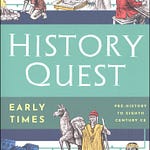Hi! I wanted to give you a walkthrough of a curriculum we’re starting next week since we school year round. This curriculum can be used in the classroom or at home if you’re a homeschooling family.
Scope and Sequence: Like I said, I started with Level 2 because that would be the best fit for my 9 year old, but I wanted you to see the full scope and sequence of all levels.
What skills it covers:
Phonics
Structural analysis (ex: breaking down base words from affixes)
Morphemic analysis (ex: adding suffix to change part of speech)
Vocabulary (we’re going to keep a vocabulary log)
Spelling (based on patterns/rules)
Fluency and comprehension (includes accuracy checklist, word proficiency graph, and fluency graph for students to track their own data—love this element of independence)
How it’s set up:
Instead of units, Megawords is broken down by word lists that follow specific rules/patterns. For example, list 9 (first list of level 2) contains consonant suffixes and plurals.
Each list is taught in the same 6 steps using a collection of practice pages.
The teacher manual breaks down a list based on the steps and which practice pages go with each step.
The steps are as follows:
Work with one-syllable words and word parts
Work with combined word parts
Work with the whole word
Work with words in context
Monitor progress to increase reading and spelling accuracy
Monitor progress to build reading proficiency
Why I’m using it:
It looked like a great way to round out some of the learning from Spellography Level A while also introducing some concepts that level didn’t include. It also introduces concepts we will see in level B of Spellography. I love the idea of returning to a concept in a different way through another program. That way, we really solidify those concepts!
It incorporates reading passages; whereas, Spellography does not include reading passages.
This resource gives me an opportunity to gather specific data (actually, she gathers it) on her accuracy and fluency. We have focused more heavily on spelling with Spellography, but I would like to make sure her reading fluency and comprehension are strong and collecting explicit data will help with that.
Advantages:
Covers a variety of skills & ties them all together through a centralized list
Includes reading passages
Reinforces the idea of syllabication (which is really helpful for spelling and reading multisyllabic words)
Ties in nicely with Spellography level A
Provides some light scripting in the teacher manual without it feeling inflexible
Teaches kids how to change parts of speech using suffixes. (The high school English teacher part of me LOVES this.)
Disadvantages:
Only in black and white
Teacher manual is almost 2x as much as the student workbook. I think it’s a necessary purchase, but I don’t think it’s worth $30, honestly. However, $50 for both the teacher manual and student workbook is pretty decent.
No calendar for how long to spend on each practice page or step (which I actually see as an advantage, but I’m putting it under disadvantage where I feel most people would put it, especially since it gives no sample schedules).
Some pages require kids to rewrite entire sentences, so based on how much writing they’re doing for other activities in the day, it could be cumbersome.
My plan for using it (so far):
First, we finished Spellography Level A.
Then, we did more work with prepositional phrases.
Next, we’re going to complete list 9, which I’m guessing will take around 2 weeks.
After we complete List 9, we will tie together prepositional phrases from Spellography and nouns from list 9 of Megawords 2 to create prepositional phrase poetry (resource I created).
Note on scheduling:
You could likely get level 2 done in 12 weeks if you schooled 4x a week.
If you spread this out over the course of a year, you could take about a month for each list and finish two levels in a year.
Level 2 is recommended for grades 5-6, so you could finish this in one school year (without schooling year round) without much trouble!
Megawords vs. Spellography:
I really don’t think this is an either/or situation.
Spellography is colorful, threads a storyline/character set through each level, and heavily reinforces phonemic/phonological awareness. Spellography centers around the layers of language as they relate to spelling, which obviously impacts reading but reading comprehension isn’t a component of this program.
Megawords, on the other hand, incorporates spelling, but it’s largely for the purpose of reading proficiency. Megawords is heavy on syllabication, provides reading passages, and progress monitoring.
As I dive into both of these programs, I see how well they feed into one another, especially since they’re both relying on the same body of research and prioritize explicit, systematic instruction on word knowledge.
Where to purchase:
There are some copies on Amazon, but I couldn’t find the newest addition there, and I wasn’t sure how much had changed between this edition and that one. To err on the side of caution, I went with the most recent addition on Rainbow Resources.
I am making this post available to free subscribers and opening up comments for everyone. Generally, comments are for my paid subscribers only!













Share this post